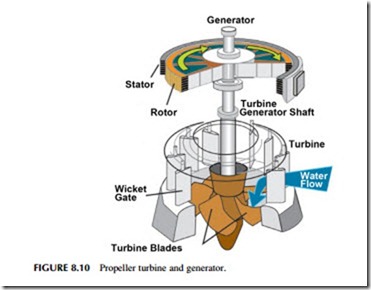GENERATORS
The turbine in a hydropower plant is connected directly to a generator to pro- duce electricity, as shown in Figure 8.10. Generators for large hydropower turbines are normally synchronized to a grid at 50 Hz or 60 Hz and this controls the speed at which both the turbine and generator must rotate.
Turbine speed will vary with turbine type. For a Pelton turbine the typical rotational speed is 400–1000 rpm. Francis turbines typically rotate between
100 rpm and 1500 rpm. Propeller turbines, meanwhile, run at speeds between 60 rpm and 300 rpm. In each case the generator must be tailored to suit the turbine speed.
A synchronous generator cannot operate at any speed but instead must turn at one of a number of fixed speeds. Flexibility of generator rotational speed is achieved by varying the number of poles. The smaller the number of poles, the higher the rotational speed needed to achieve a given synchronization frequency. For 50 Hz operation a two-pole generator must rotate at 3000 rpm, while a 60 Hz machine must rotate at 3600 rpm. For eight-pole generators the necessary speeds would be 750 rpm and 900 rpm. Therefore, generators for slow-speed turbines require a larger number of poles.
While most large hydropower plants rely on synchronous generators of this type, an increasing number of smaller units are starting to employ variable- speed generators. These can operate at any speed, the latter being determined to optimize efficiency. Output from the generator is then converted to grid frequency using solid-state power electronic devices. The power-handling capabilities of the latter generally limit the generator size to tens of megawatts.
Related posts:
Incoming search terms:
- hydro generator are generally employed to run at
- Hydro generator is are generally employed to run at ……………rpm
- hydro generators are generally employed to run at
- hydrogenerator are employed to operate at rpm
- Pelton Turbine Generator CNC Machined Francis mail
- what do a generator posses in a hydrothermal power station
- what is the RPM of a Hydrogenerator in a dam
